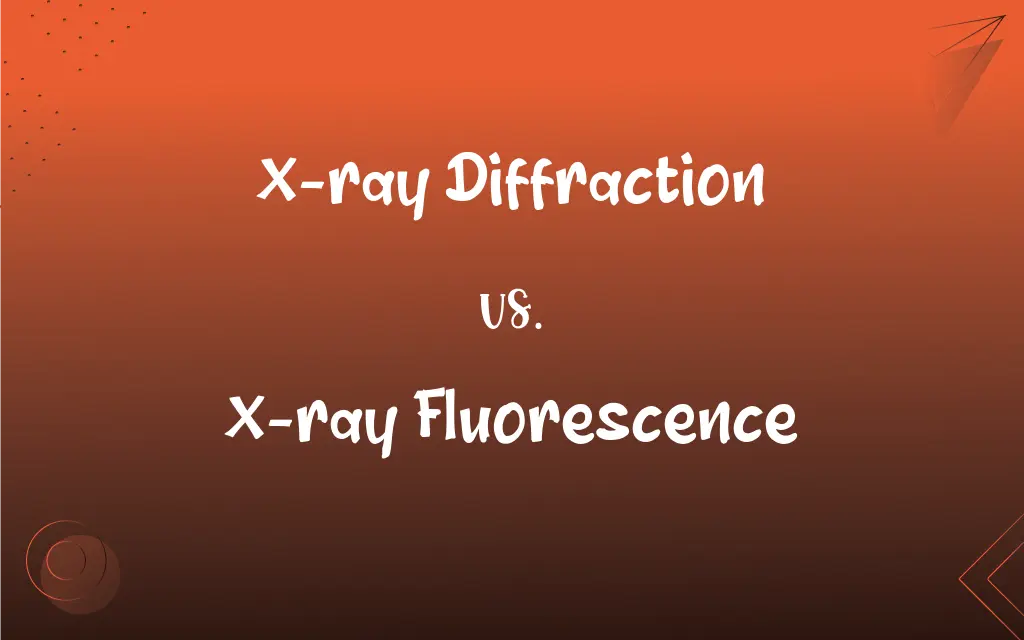X-ray Diffraction vs. X-ray Fluorescence: What's the Difference?
Edited by Aimie Carlson || By Harlon Moss || Published on February 19, 2024
X-ray diffraction analyzes crystal structure by measuring the pattern of X-rays diffracted by crystals, while X-ray fluorescence identifies elements by detecting characteristic X-rays emitted from materials.

Key Differences
X-ray Diffraction is primarily used to determine the crystalline structure of materials. It involves measuring the angles and intensities of diffracted X-rays. X-ray Fluorescence is employed for elemental analysis, where the emitted X-rays from a sample are measured to identify and quantify elements.
In X-ray Diffraction, X-rays interact with the electron cloud of atoms, producing a diffraction pattern that reveals the atomic arrangement. X-ray Fluorescence occurs when a material is excited by X-rays, causing it to emit secondary X-rays that are characteristic of the elements present.
X-ray Diffraction is crucial for understanding the molecular or atomic structure, used in fields like mineralogy and materials science. X-ray Fluorescence is widely used for qualitative and quantitative chemical analysis, essential in geochemistry and metallurgy.
The data from X-ray Diffraction can determine phase identification, crystal structure, and crystallographic properties. X-ray Fluorescence provides information about the elemental composition of a sample, including trace elements.
X-ray Diffraction techniques require a crystalline or semi-crystalline sample for analysis. In contrast, X-ray Fluorescence can analyze both crystalline and non-crystalline materials, including liquids and powders.
ADVERTISEMENT
Comparison Chart
Primary Use
Analyzing crystal structure
Elemental composition analysis
Interaction with Matter
Diffraction by atomic lattice
Emission of secondary X-rays
Application Fields
Mineralogy, materials science
Geochemistry, metallurgy
Information Obtained
Atomic arrangement, crystal properties
Elemental identity and concentration
Sample Requirements
Crystalline or semi-crystalline
Crystalline, non-crystalline, liquids
ADVERTISEMENT
X-ray Diffraction and X-ray Fluorescence Definitions
X-ray Diffraction
A method involving the scattering of X-rays by crystal lattices.
The scientist analyzed the diffraction patterns to understand the material's properties.
X-ray Fluorescence
Used for non-destructive chemical analysis of materials.
X-ray fluorescence provided a non-destructive way to analyze the painting's pigments.
X-ray Diffraction
Used for identifying crystalline phases and their orientation.
X-ray diffraction helped in identifying the different phases in the alloy.
X-ray Fluorescence
A technique to measure the concentration of various elements.
They used X-ray fluorescence to measure the concentration of pollutants.
X-ray Diffraction
A process to determine the arrangement of atoms in a crystal.
They used X-ray diffraction to study the atomic arrangement in the new compound.
X-ray Fluorescence
Involves exciting atoms in a sample and analyzing emitted X-rays.
The artifact was analyzed using X-ray fluorescence to determine its elemental makeup.
X-ray Diffraction
Involves measuring the spacing between layers of atoms.
The spacing between atomic layers was measured using X-ray diffraction.
X-ray Fluorescence
A method for determining elemental composition of a sample.
X-ray fluorescence revealed the presence of trace metals in the soil.
X-ray Diffraction
A technique to study atomic or molecular structure of materials.
X-ray diffraction was used to determine the crystal structure of the mineral.
X-ray Fluorescence
Involves detecting secondary X-rays emitted from a material.
Secondary X-rays emitted from the sample were detected using X-ray fluorescence.
FAQs
What is X-ray fluorescence?
A method for analyzing the elemental composition of materials by detecting emitted X-rays.
How does X-ray diffraction work?
It analyzes diffraction patterns formed when X-rays interact with a material's atomic lattice.
What is X-ray diffraction used for?
It's used in material science, mineralogy, and crystallography to study atomic structures.
What is X-ray diffraction?
A technique to study the structure of crystalline materials using X-ray scattering.
Can X-ray diffraction analyze liquids?
It's primarily used for crystalline or semi-crystalline solids, not liquids.
What does X-ray fluorescence measure?
It measures the characteristic secondary X-rays emitted by different elements in a sample.
Do both methods require sample preparation?
Yes, but the extent varies depending on the technique and the sample.
How accurate is X-ray fluorescence?
It's highly accurate for elemental analysis, including trace elements.
Can X-ray fluorescence analyze organic materials?
Yes, it can analyze both organic and inorganic materials.
Is X-ray fluorescence destructive?
No, it's a non-destructive analytical technique.
Can X-ray diffraction identify elements?
It's more focused on structural analysis than elemental identification.
What kind of samples can X-ray diffraction analyze?
Crystalline solids or powders.
What applications does X-ray fluorescence have?
It's used in geochemistry, material science, and archaeology for elemental analysis.
What information does X-ray diffraction provide?
Information about the spacing and arrangement of atoms in a crystal lattice.
Are there limitations to X-ray fluorescence?
Yes, it may be less effective for elements with very low atomic numbers.
Is specialized training required to use X-ray diffraction?
Yes, proper training is needed to interpret diffraction patterns accurately.
What safety precautions are needed for X-ray diffraction?
Proper shielding and safety protocols are essential to protect from X-ray exposure.
Can X-ray fluorescence detect all elements?
It's effective for most elements, particularly those with higher atomic numbers.
Can X-ray fluorescence be used on artifacts?
Yes, it's commonly used in archaeology for non-destructive testing.
Is X-ray diffraction a quick process?
The speed can vary, but modern equipment allows for relatively fast analysis.
About Author
Written by
Harlon MossHarlon is a seasoned quality moderator and accomplished content writer for Difference Wiki. An alumnus of the prestigious University of California, he earned his degree in Computer Science. Leveraging his academic background, Harlon brings a meticulous and informed perspective to his work, ensuring content accuracy and excellence.
Edited by
Aimie CarlsonAimie Carlson, holding a master's degree in English literature, is a fervent English language enthusiast. She lends her writing talents to Difference Wiki, a prominent website that specializes in comparisons, offering readers insightful analyses that both captivate and inform.
































































